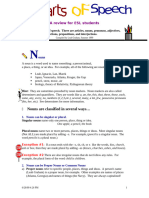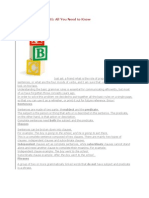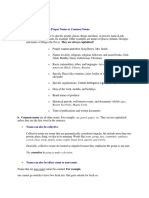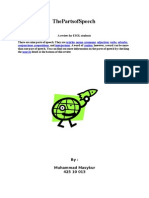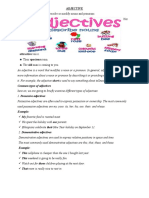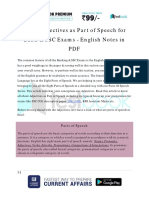Adjective & Adverb - Id.en PDF
Adjective & Adverb - Id.en PDF
Uploaded by
Pungkas PrastawaCopyright:
Available Formats
Adjective & Adverb - Id.en PDF
Adjective & Adverb - Id.en PDF
Uploaded by
Pungkas PrastawaOriginal Title
Copyright
Available Formats
Share this document
Did you find this document useful?
Is this content inappropriate?
Copyright:
Available Formats
Adjective & Adverb - Id.en PDF
Adjective & Adverb - Id.en PDF
Uploaded by
Pungkas PrastawaCopyright:
Available Formats
Translated from Indonesian to English - www.onlinedoctranslator.
com
Adjective
1. Definition of Adjectives
Adjectives are adjectives that function to explain or limit pronouns and nouns that are still
general in nature and can be in the form of people, places, animals, objects or abstract
concepts.
2. Types and Examples of Adjectives
Adjectives are divided into two types, namely descriptive nouns and limiting adjectives, along with an
explanation.
a. Descriptive nouns
Descriptive nouns are adjectives that describe and explain the state of a noun or pronoun in
the form of size, shape, color, smell, taste and so on. It consists of six patterns as follows:
1. Character and quality, for example kind, friendly, humble, arrogant, charitable, careful,
greedy, lazy, helpful, bad, ugly, smart, handsome, beautiful, pretty, smart and so on.
2. Size, for example short, long, low, big, small, huge, tall, high, narrow, thick, wide, far,
near, thin and so on.
3. Age and temperature, for example warm, hot, cold, old, young, ancient, modern and
so on.
4. Participles (verb – ing and Verb3), for example amazed, amazing, scaring, scared, bored,
boring, tired, tiring, confused, confusing, interested, interesting and so on.
5. Shape, for example oval, cube, circle, square, triangle and so on.
6. Color, for example reddish, blue, yellowish, crimson, purple, white, black and
so on.
Examples of descriptive nouns in sentence form,
1. A pretty tall young smiling girl
2. Three large old abandoned buildings
3. His small round reddish cheeks
b. Limiting adjectives
Limiting adjectives, are adjectives that limit nouns or pronouns without providing
information about conditions, types and so on. These limiting adjectives are divided into
eight as follows:
- Possessive adjectives,is a possessive adjective followed by a noun. For
example (your) book, (our) food, (her) dress, (its) name, (his) money, (my) hat.
The word in brackets is a possessive adjective, while the word after it is a
noun.
- Possessive proper adjectives,is a form of ownership that uses a noun as its
adjective. For example, the girl (singular noun) becomes the girl's; my husband
(singular noun) to be my husband's; Edward (singular noun) becomes edward's.
To use a possessive proper adjective in a singular noun, add an apostrophe or
one-quote mark and the ending –s. Meanwhile, in plural nouns, you can only add
an apostrophe.
- demonstrative adjectives,is a demonstrative word followed by a noun. For example,this book is mine,
that book is hers, I wrote these books, those dogs are cute.
- Article adjectives, is an article that is placed in front of a noun and consists of a; an
and the; for example, an umbrella, a baseball. The prefix an is used for words that
start with a vowel, while the prefix a is used for words that start with a consonant.
- Exclamatory adjective,is an adjective that is used for sentences or words with exclamation
marks. For example what a lucky boy he is!, what a bright sun it is!. Of the two sentences, the
exclamatory adjective has a pattern, namely what + a/ an + noun / pronoun (subject
+ verbs) !
- interrogative adjectives,is an adjective used to ask questions. Can be used with what
+ noun, whose + noun, which + noun. For examplewhat time is ti? What a bright sun
isn't it? Which book did you bring? numeral adjective,as the name implies this
- adjective is a number that functions as an adjective. It is divided into three types,
namely cardinal numbers, ordinal numbers, and multiplication. For example,one year,
two months (cardinal number), the first edition, the seventh line (ordinal number), a
pair of shoes, single room (multiplication). Adjective of indefinite quantity, is a
- number that is not clear and functions as an adjective. For examplemany mistakes,
much money, a few times.
adverb
1. Definition of Adverb
According to the Cambridge Dictionary, an adverb is an auxiliary word that has a function to
provide additional information about the verb, adjective, or adverb itself. However, in using
adverbs well, Grameds also has to practice English vocabulary properly by using the Smart Picture
Dictionary of English.
Adverbs have several characteristics, viz.
1. Adverbs can be additional information
2. Adverbs can be placed in front, behind or separately from the previous word
3. Adverbs are usually in the form of adjectives with the addition of –ly
4. Adverb cannot be a noun
2. Types and Examples of Adverbs
Adverbs have five types which are divided based on their use. Following are the types and examples of
adverbs.
- Adverb of time, is an adverb that is used to provide additional information about
time. For example, now, early, yesterday, tomorrow, today, soon, late, the day
after tomorrow, the day before and so on.
- Adverb of place, is an adverb that functions to provide additional information
about a location or place. For example there, home, down, here, somewhere and
so on.
- Adverb of degree, is an adverb that is used to add or complete information. For
example, just, almost, quite, enough, too, extremely, very and so on. Adverb of
- manner, is an adverb that is used to add information about conditions or explain
how an event happened. The form is in the form of adjective + ly, for example
softly, gently, happily, easily and so on.
- Adverb of frequency, is an adverb that is used to provide information about how
often someone does something. For example never, always, occasionally and so
on.
You might also like
- English Grammar 101Document21 pagesEnglish Grammar 101Dharmarao BalagaNo ratings yet
- English 7 ReviewerDocument61 pagesEnglish 7 ReviewerDaisy Orbon100% (3)
- English Grammar All You Need To KnowDocument22 pagesEnglish Grammar All You Need To KnowDavid Fueter0% (1)
- World English 2 - Workbook Unit 11 Alexandra AriasDocument6 pagesWorld English 2 - Workbook Unit 11 Alexandra AriasALEXANDRA ARIAS VALDERRAMANo ratings yet
- Tugas Bahasa Inggris Part of SpeechDocument9 pagesTugas Bahasa Inggris Part of SpeechauliaNo ratings yet
- Parts of SpeechDocument5 pagesParts of SpeechManzoorNo ratings yet
- Noun Etc.Document29 pagesNoun Etc.Basuki RahmatNo ratings yet
- Modul Bahasa InggrisDocument28 pagesModul Bahasa InggrisJ4 LiusNo ratings yet
- Grammar Guide: 1. WordsDocument16 pagesGrammar Guide: 1. WordsRania FarranNo ratings yet
- Parts of SpeeckDocument13 pagesParts of SpeeckMarietta SzabóováNo ratings yet
- Teaching and Assessment of Grammar Midterm CoverageDocument4 pagesTeaching and Assessment of Grammar Midterm CoverageRoselyn AlbisoNo ratings yet
- Adjectives ScriptDocument6 pagesAdjectives ScriptDeeksha sharmaNo ratings yet
- English Grammar 101Document8 pagesEnglish Grammar 101Chris Hogan100% (1)
- 4 Skills HafDocument9 pages4 Skills HafAbdul Rahman AlhufashiNo ratings yet
- Eng Worksheet Grammar 2Document12 pagesEng Worksheet Grammar 2Neha KalraNo ratings yet
- Eng Mod1Document26 pagesEng Mod1Tivar VictorNo ratings yet
- Adjectives CutieDocument5 pagesAdjectives CutieSweet lea AntonesNo ratings yet
- Skill FinalDocument37 pagesSkill Finalkalai cgmNo ratings yet
- LPAT_notesDocument26 pagesLPAT_notespoonrita66No ratings yet
- Grammar 101Document14 pagesGrammar 101Reza Ayah MaharaniNo ratings yet
- English Grammar 101Document10 pagesEnglish Grammar 101Talibovic TalibovNo ratings yet
- Word ClassesDocument4 pagesWord Classestahminaakter9091No ratings yet
- English Oh ReadDocument115 pagesEnglish Oh Readjoc3lyn_nNo ratings yet
- Let-Notes-Gen Edprof EdDocument102 pagesLet-Notes-Gen Edprof Edsirk01251994No ratings yet
- Sentences: (TUTORIAL) All About Grammars & TensesDocument69 pagesSentences: (TUTORIAL) All About Grammars & Tenses3vilcatNo ratings yet
- Pronouns Dan AdjectiveDocument8 pagesPronouns Dan AdjectiveNancy IndahNo ratings yet
- Nouns Can Be Proper Nouns or Common NounsDocument18 pagesNouns Can Be Proper Nouns or Common NounsSi Aby ReyesNo ratings yet
- Road To English BetterDocument65 pagesRoad To English BetterEko Nurhadi SatrioNo ratings yet
- Grammar Complete NotesDocument34 pagesGrammar Complete Notesfarhad.mr37100% (1)
- Unit One and TwoDocument12 pagesUnit One and Twoqamer.saffaNo ratings yet
- Parts of SpeechDocument48 pagesParts of SpeechAmna ShoukatNo ratings yet
- Types of Parts of Speech NounDocument20 pagesTypes of Parts of Speech NounNurul Aida NionsiNo ratings yet
- Parts of Speech in EnglishDocument23 pagesParts of Speech in EnglishNina fauziah100% (2)
- SpeechDocument15 pagesSpeechMahboob RiazNo ratings yet
- Parts of Speech-1Document7 pagesParts of Speech-1Chithra ShreeNo ratings yet
- English Basic GrammarDocument12 pagesEnglish Basic GrammaribnuamungNo ratings yet
- General Understanding of English Language For Ordinary LevelDocument171 pagesGeneral Understanding of English Language For Ordinary LevelJOHNNo ratings yet
- 9 Parts of SpeechDocument13 pages9 Parts of Speechmasykur8d1No ratings yet
- SYNTAXDocument12 pagesSYNTAXahyennkhrysselle22No ratings yet
- All About GrammarDocument56 pagesAll About GrammarDeka Fab100% (1)
- Sentences: Independent Clauses Act As Complete Sentences, While Subordinate Clauses Cannot Stand Alone andDocument9 pagesSentences: Independent Clauses Act As Complete Sentences, While Subordinate Clauses Cannot Stand Alone andThamizhman Mani100% (1)
- A Word and Its Form InflectionDocument17 pagesA Word and Its Form InflectionErvin EXorcistNo ratings yet
- amesnaou (1)Document46 pagesamesnaou (1)elmoumenhossamNo ratings yet
- Modul 10: Blue, and Sharp Are Descriptive, and They Are All Examples of Adjectives. BecauseDocument6 pagesModul 10: Blue, and Sharp Are Descriptive, and They Are All Examples of Adjectives. BecauseChaerunnisa100% (1)
- English Assignment 1Document22 pagesEnglish Assignment 1katilabbuNo ratings yet
- English 101Document12 pagesEnglish 101Joshua BetenioNo ratings yet
- Parts of SpeechDocument45 pagesParts of SpeechVitaManiezt100% (3)
- English Materials 1Document54 pagesEnglish Materials 1Sen SaddamNo ratings yet
- ADJECTIVEDocument8 pagesADJECTIVEABREHAMNo ratings yet
- GuidebookDocument41 pagesGuidebookdylandavid987No ratings yet
- Grammar FundamentalsDocument14 pagesGrammar FundamentalsVishad VatsNo ratings yet
- Parts of Speech - Full BookDocument45 pagesParts of Speech - Full BookAISHWARYA EDUCATIONNo ratings yet
- Bahasa Inggris Bisnis 1Document59 pagesBahasa Inggris Bisnis 1Agung Junaedy100% (1)
- Learn Adjectives As Part of Speech For Bank 2Document11 pagesLearn Adjectives As Part of Speech For Bank 2waseemNo ratings yet
- Day 3 - General EducationDocument33 pagesDay 3 - General EducationJessamen TinoNo ratings yet
- Chap 10 Cao Thu HienDocument25 pagesChap 10 Cao Thu HienSunny100% (1)
- Word FunctionsDocument4 pagesWord FunctionsshanteyarthurNo ratings yet
- English Adjectives Made Easy: An Essential Guide to Rules and Examples of English AdjectivesFrom EverandEnglish Adjectives Made Easy: An Essential Guide to Rules and Examples of English AdjectivesNo ratings yet
- Comprehensive English Grammar Guide: From Basics to Competitive ExcellenceFrom EverandComprehensive English Grammar Guide: From Basics to Competitive ExcellenceNo ratings yet
- 7 Days to Grammar Excellence: How to Master English from Beginner to AdvancedFrom Everand7 Days to Grammar Excellence: How to Master English from Beginner to AdvancedNo ratings yet
- A Deep Dive Into Nouns : A Beginner Study To All Forms of Nouns: Black Genius Academy, #1From EverandA Deep Dive Into Nouns : A Beginner Study To All Forms of Nouns: Black Genius Academy, #1No ratings yet
- Meaningless Meetings - Adv Biz English LessonDocument9 pagesMeaningless Meetings - Adv Biz English LessonBarbariskovna IriskaNo ratings yet
- Naming TheoryDocument22 pagesNaming TheoryIts VirgoNo ratings yet
- All Grammers RulesDocument65 pagesAll Grammers RulesashishmstudyNo ratings yet
- Lecture 5Document22 pagesLecture 5Даша МусурівськаNo ratings yet
- CL Review Questions for Mid-term TestDocument5 pagesCL Review Questions for Mid-term TestmalunelumiereNo ratings yet
- The English Hub_1_Test 4Document5 pagesThe English Hub_1_Test 46dorothy6No ratings yet
- reflect 4Document10 pagesreflect 4Bảo NguyênNo ratings yet
- Lecture Notes2 - IDocument40 pagesLecture Notes2 - IAlex HaghiacNo ratings yet
- Copia de Cuestionario - Inglés Alumnos C EDITADO 2022Document49 pagesCopia de Cuestionario - Inglés Alumnos C EDITADO 2022gabriel.arcentales.morenoNo ratings yet
- EL 107 FinalsDocument3 pagesEL 107 FinalsHillary Joy RufinoNo ratings yet
- MacKenzie, D. N., (1956), Bāǰalānī, Pp. 418-435. Bulletin of The School of Oriental and African StudiesDocument19 pagesMacKenzie, D. N., (1956), Bāǰalānī, Pp. 418-435. Bulletin of The School of Oriental and African StudiesKurdish textsNo ratings yet
- Unit 2 Relationships Lesson 8 Looking Back and ProjectDocument18 pagesUnit 2 Relationships Lesson 8 Looking Back and ProjectNgân Vĩnh TrươngNo ratings yet
- Lesson 2using Correct Intonation - Yes - No - QuestionsDocument5 pagesLesson 2using Correct Intonation - Yes - No - QuestionsobingcubianNo ratings yet
- The Study of Presupposition As A Pragmatic PhenomenonDocument5 pagesThe Study of Presupposition As A Pragmatic PhenomenonAcademic JournalNo ratings yet
- ET - 02 (C Unit) Written QuestionDocument1 pageET - 02 (C Unit) Written Questionmolomparty806No ratings yet
- 35 Hilarious Chinese Translation Fails Bored PandaDocument1 page35 Hilarious Chinese Translation Fails Bored Pandarohitkb7782No ratings yet
- Wh-Words NewDocument5 pagesWh-Words NewMOISES VAZQUEZNo ratings yet
- All Chapters XIDocument15 pagesAll Chapters XIFANISA AMRINo ratings yet
- Lesson PlanDocument10 pagesLesson PlanVANESSA MOLUDNo ratings yet
- ALM and GTMDocument2 pagesALM and GTMJiovanna LoaNo ratings yet
- BIG - Present Perfect Vs Present Perfect ContinuousDocument3 pagesBIG - Present Perfect Vs Present Perfect ContinuousRoif Syahnureka100% (1)
- 21st CENTURY LIT ANSWER SHEET Q1 Week 1Document2 pages21st CENTURY LIT ANSWER SHEET Q1 Week 1Nea Besmonte0% (1)
- Wider World Product PresentationDocument64 pagesWider World Product PresentationMichal VaněkNo ratings yet
- English Review: 1. Tenses To Describe Charts/trends: Simple TensesDocument7 pagesEnglish Review: 1. Tenses To Describe Charts/trends: Simple TensesFiras ChattaouiNo ratings yet
- Grenade .Bruno MarsDocument2 pagesGrenade .Bruno MarsAuto diagnostico Trabajo en casaNo ratings yet
- Poetry RubricDocument2 pagesPoetry RubricRAISA BINTI RAUS MoeNo ratings yet
- NCERT Solutions For Class 9 English Feb 13 Beehive Chapter 4 A Truly Beautiful MindDocument5 pagesNCERT Solutions For Class 9 English Feb 13 Beehive Chapter 4 A Truly Beautiful MindApangshu DasNo ratings yet
- Hoc Sinh Gioi Anh 6 Sach Thi Diem Cuc HayDocument5 pagesHoc Sinh Gioi Anh 6 Sach Thi Diem Cuc HayĐặng Thị DungNo ratings yet
- Prepare To Read: Key VocabularyDocument42 pagesPrepare To Read: Key VocabularyAndre Fonseca0% (1)


















